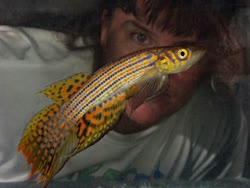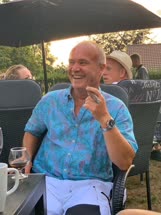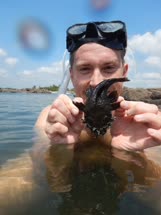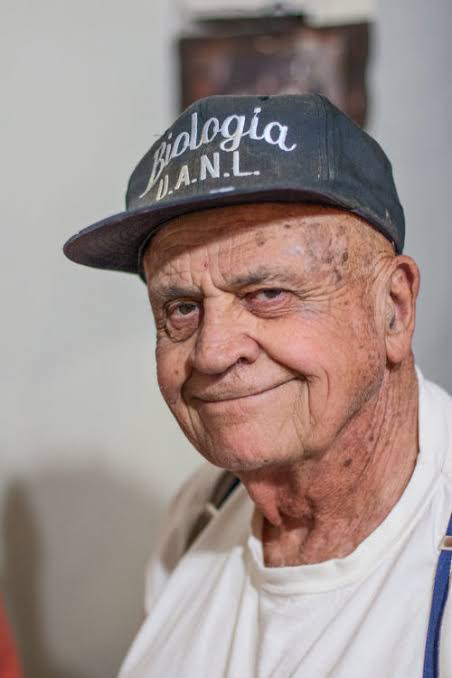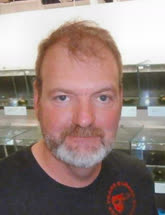|
|
Belinda peck behind her namesake Moema quii after a local shaman in Peru gave her the nickname "Qui".
Lance and Belinda explore and collect in Peru for both new species but also salvageable reclaimed forest hardwood for lutier applications.
|
Jan Ole Pedersen - Died July 29, 2021
When he was well he was one of the most creative, colorful and generous people we have known.
He was one of the most knowledgeable about aquarium plants and how to give them good growing conditions.
One of the world's great creative aquascapers. (Plant aquariums as art)
When he was well, he had a sense of humor, special taste in clothes, and spectacular events that helped to spread laughter and experiences.
The last few years were very difficult for him, the mental temperament fluctuated more and more up and down, and eventually the physical health failed. And the bright moments became fewer.
He eventually decided not to live anymore.
Have wanted to be burned and the ashes scattered without ceremony.
He has bequeathed his fortune to "Børns Vilkår" which works to ensure that no children in Denmark are let down.
Honor be his memory
Holger Windeløv, Ib Madsen and Claus Christensen
|
|
Zookeeper, aquarist, explorer, publisher of amazonas.dk.
|
Edwin Pister - Desert fishes
Edwin “Phil” Pister (1929-2023)
On August 18, 1969, a fishery biologist for the California Department of Fish and Game named Edwin “Phil” Pister held the fate of an entire vertebrate species — the Owens Pupfish (Cyprinodon radiosus) — in two buckets.
The pupfish was once a common inhabitant of the vast marshlands that stretched throughout eastern California’s Owens Valley. But decades of habitat destruction and the introduction of nonnative largemouth bass (“chainsaws with fins,” Phil called them) reduced the pupfish’s population to just one: a room-sized spring-fed pond called Fish Slough. The pond was almost completely dry when Phil got the call. He dropped what he was doing — ironically, planning the introduction of nonnative trout into a manmade reservoir — and gunned it to Fish Slough.
There was no time to think. Phil and a colleague netted the surviving 800 pupfish, placed them into three wire mesh cages, and sunk the cages into the main channel of the slough. Later they would scout out more favorable locations and move the fish again. After a quick dinner break Phil returned to complete his work, only to discover hundreds of dead and dying pupfish. Unfortunately, in his haste to rescue the species, Phil had placed the cages in eddies just outside of the slough’s main current.
Dangerously low water levels and insufficient oxygen were taking their toll on the overcrowded pupfish, already stressed by unavoidably rough treatment on a hot summer afternoon in the middle of the desert. Temporarily alone in the marsh, Phil ran to his pickup truck, grabbed the only two buckets he had, and netted the gasping fish. He had to find someplace to move them now or the species would go extinct.
Phil was scared to death. As he lugged the two buckets, each weighing more than 30 pounds, over the uneven marsh terrain, he worried about tripping over barbed wire or stepping into a rodent burrow. “Please don’t let me stumble,” he pleaded with himself. “For a few frightening moments,” he later remembered, “there was only myself standing between life and extinction.”
Phil did not stumble. The Owens pupfish survives in two well-protected refugia. And Phil went on to found and lead the Desert Fishes Council (DFC). The mission of the DFC is to preserve the biological integrity of desert aquatic ecosystems and their associated life forms, to hold symposia to report related research and management endeavors, and to effect rapid dissemination of information concerning activities of the Council and its members.
This morning we woke up to the sad news that Phil passed away yesterday from heart failure.
Two desert fishes are named in Phil’s honor:
The Palomos Pupfish, Cyprinodon pisteri Miller & Minckley 2002, occurs in the Lago de Guzmán basin of Chihuahua, Mexico. The authors wrote: “For almost four decades, Phil Pister has unerringly and effectively performed the daunting task of preserving the integrity of natural aquatic habitats and biotas in North American deserts, along the way teaching others to do the same. His infectious and tireless persistence, enthusiasm, optimistic outlook, and unique capability to redirect conflicting views toward common goals have led to significant and enviable successes in equating science and a strong environmental ethic with political reality.”
Fundulus philpisteri García-Ramírez, Contreras-Balderas & Lozano-Vilano 2007 occurs in Baño de San Ignacio and nearby springs in Nuevo León, Mexico. The authors honored Phil for his dedication to the study and teaching of ichthyology, and for promoting the conservation of the desert fishes and their ecosystems.
The common name for F. philpisteri is Conservationist Killifish. - Ken Lazara
|
|
Max Poll was a notable ichthyologist working on African fishes. There is a "polli" in many African genera.
|
|
|
|
|
Ichthyologist in Congo
Discovered the locality of Fundulopanchax spoorenbergi in 2024, solving a 48 year old riddls - the species was found only once before when it came arrived in a commercial shipment with no locality information; they were never found again. They still exits in aquaria today and are popular. Now we know where they're from.
|
|
Grand scale aquascape artist, Indonesia.
|
|
Charles Bruce Powell
No, that's not an early picture of Gordon Lightfoot, this is a different Canadian, Charles Bruce Powell, an ichthyologist from New Brunswick who took a teaching job in Africa after graduating university. A few fish are named after him, including the very rare Fundulopanchax powelli, a large relic form of killifish that only Powell himself has seen alive and only one specimen exists preserved in a museum, further attempts to find it have failed. The fish proved interesting because the genus could not be place and the definition of Fundulaopanchax had to be changed as it had defining characters for both Aphyosemion and Fundulopanchax.
His biography was written up by a coollegue in Africa and can be found at here: https://www.jstor.org/stable/20105513
|
|
|
